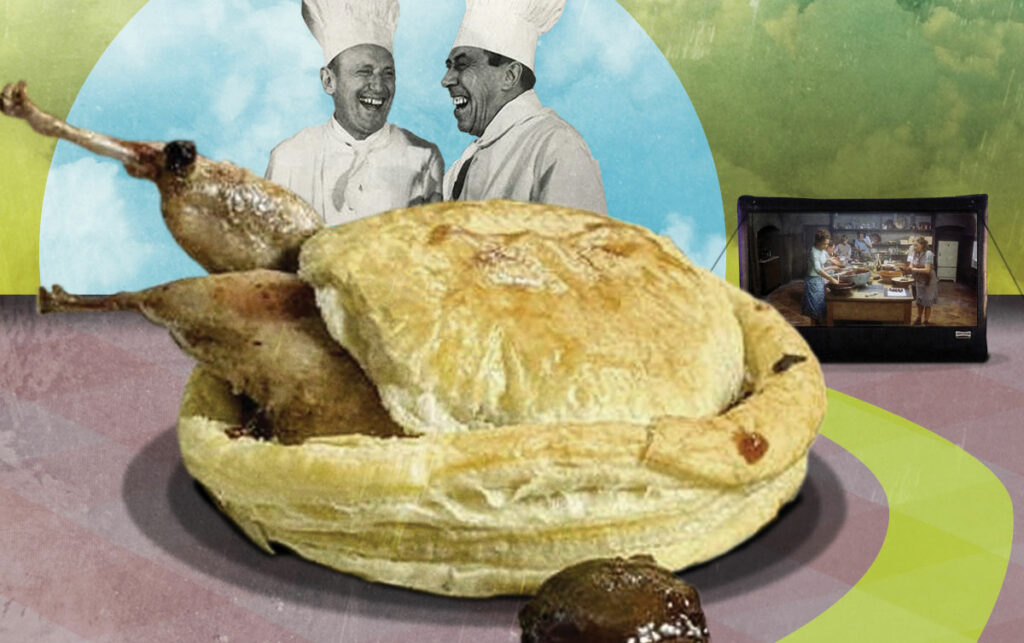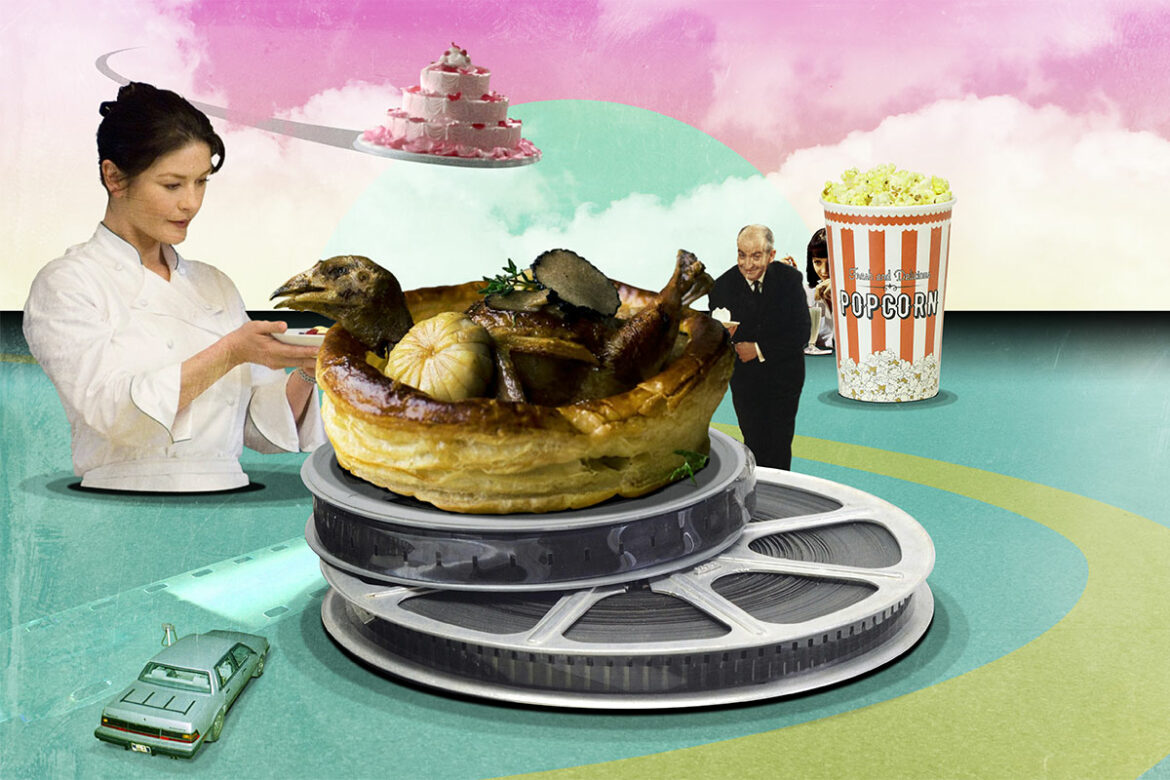Art, Artists, and Babette’s Feast
Food and film have been entwined ever since Charlie Chaplin stabbed two bread rolls with forks and performed his little dance. In some movies—Eat Drink Man Woman (1994) or Moonlight (2016)— cooking is an act of love. In Tampopo (1985), food replaces sex for the ramen fetishist (plus, the yakuza who passes a raw egg yolk to his girlfriend via a kiss), while the taken cannoli in The Godfather (1972) and the pastry porn montage in Marie Antoinette (2006) use food to dramatize corrupted values. But the film that uses food to explore feminism, religion, art, and the place of sensuality in culture, is the ultimate food film: Babette’s Feast (1987).
Set in a remote Danish seaside village and shot in near greyscale, the story follows two pious middle-aged sisters, both former beauties. One, Martine, sacrificed a romance with a Swedish soldier, while the other, Filippa, sacrificed a career as an opera singer—both acts to serve their father, an acetic, puritanical Lutheran minister. After his death, they continue their father’s ministry, distributing gruel to the poor.
One night, a ship delivers Babette Hersant to the sisters; she’s a letter-bearing Parisian whose son and husband were recently killed in the overthrow of Napoleon III. Her letter’s writer, the opera star who’d identified Filippa’s singing talent, recommends Babette to the sisters as a servant, saying that “she can cook.” The sisters refuse: they can’t afford a servant. But when Babette threatens suicide, they take her on unpaid.
In a scene where the sisters patiently show Babette how to prepare the alms gruel, there’s look on Babette’s face: it’s pity. This is our first hint that “she can cook” may be an understatement. Soon, we see Babette buying aromatics (two onions); we see her foraging for herbs; haggling with the grocer over a scrap of bacon; and charming/bullying a fisherman into lowering his price.
After 14 years, a letter arrives for Babette. A friend in France informs Babette that she’s won 10,000 francs in the lottery. Babette makes a request of the sisters: she wants to cook “un vrai dîner Français” to celebrate the dead minister’s 100-year birthday. She will not only cook but pay for the meal herself. The sisters, though uncomfortable, accede to her wish.
Live quails, blocks of ice, vintage wines, glasses, and many other mysterious barrels and crates begin to arrive from France. Watching such indulgence, the sisters become distressed—but it is the live, hissing sea turtle that causes Martine to dream that the dinner will introduce “dangerous forces that may bring evil among us.” The faithful vow that, while they will attend the dinner, they will not talk about the food; they’ll use their tongues only “for prayer.” But a last-second guest—Martine’s Swedish soldier (now a general)—is not aware of that plan.
When the guests arrive, a plain wooden table has been clothed in white and positively heaves with porcelain, silver and crystal. In the kitchen, wielding a new copper batterie de cuisine, Babette sends off turtle soup with a fine amontillado, followed by blini with caviar and vintage champagne. The shocked general, an epicure who had spent many years in Paris, praises the food and wine—while the puritans respond with comic non sequiturs. But when a dish of quails arrives, he identifies it as “cailles en sarcophage,” the signature of one renowned Parisian chef: a “culinary genius,” who was also, uniquely, a woman. The parishioners eat and drink greedily, and, in their bonhomie, several festering feuds are forgiven. After dinner, Filippa—whose voice, ‘til then, had only been used for the sect’s dirge-like hymns—sings an opera solo; meanwhile, Martine and her Swedish officer reconnect. Executed by Babette, a single “vrai dîner Français” corrects years of wrong turns.
The sisters are later horrified to discover Babette has blown her entire winnings on the dinner, but Babette has no regrets. She explains that her art has the ability to make people happy, and that “an artist is never alone.” She’s content to live in poverty with the sisters. Filippa, ever devout, knows that Babette’s art will delight angels in the afterlife, but in the film’s reality, the opportunity to practice her sensual art saves Babette’s spirit on earth (and mends an entire village).

WTF With the Quail?
CARNALITY & CAILLES EN SARCOPHAGE
In Babette’s Feast, a film that weighs art against religion, and sensuality against asceticism, one dish—cailles en sarcophage (quails in coffins)—appears more frequently than any other on screen. We see the live quails arrive and we see them being plucked. We see Babette spatchcock them, stuff their boned interiors with foie gras and truffles, then we see what remains fed to the pigs. In the cooking sequence, we see Babette carefully forming their elongated puff pastry coffins, then we see we see further truffles go into a sauce that Babette flames with cognac. At the table, we see the Swedish general lift a tiny, fragile quail head from its coffin, then crunch through its skull and suck out the juices (to the abject horror of his tablemates). Babette’s signature creation—the pinnacle of her art—doesn’t just use rarified ingredients: It celebrates carnality. Served to a group who’ve suppressed their sensuality to ensure a glorious afterlife, the dish is of the earth (the truffle), of the flesh (the foie gras and bird), and, in the tiny coffins, the dish’s beauty is in its mortality.
INTERSECTION PLAYLIST
J’aurais Toujours Faim De Toi
MUSIC ABOUT FRANCE AND LOVERS: A PLAYLIST BY ADAM REID SEXTON
Adam Reid Sexton is a writer whose books include Desperately Seeking Madonna, which Pitchfork named as one of its Best Madonna Books. His next book is titled Hang Us in the Louvre: How Pop Music Became Art—go check him out on his website, adamreidsexton.net.



